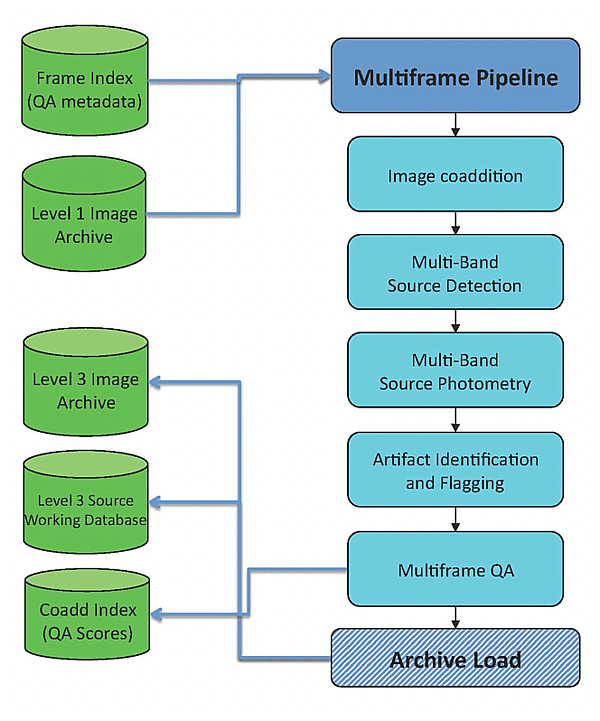


IV. WISE Data Processing
3. Pipelines
c. The Multiframe Pipeline
The WSDS Multiframe pipeline combines multiple images from
one or more scans covering the same region on the sky, detects
sources on the combined images, characterizes the detected sources
on the single-exposure and coadded images, applies photometric and
astrometric calibrations, and identifies and tags detections that may be
contaminated by or spurious detections of image artifacts produced by bright
sources.
The elements of the Multiframe pipeline processing flow are
shown in Figure 1.
The Multiframe pipeline takes as input the Single-exposure
(Level 1)
images and metadata produced by the
Scan/Frame pipeline. The Multiframe processing
steps are:
- Image coaddition - Single-exposure frame images that satisfy
minimum quality criteria (V.2) are optimally
combined on pre-defined Atlas Tile
footprints on the sky in the Atlas Image generation step
(IV.5.a). Pixel outlier rejection
is used to suppress transient features and fast moving objects.
- Multiband Source Detection - Sources are detected simultaneously
in the four WISE bands on a combined signal-to-noise image formed from the
four-band coadded images in the MDET source detection step
(IV.4.b).
- Source Extraction - Positions and photometry for detected
sources are measured in the WPHOT subsystem (IV.4.c).
Profile-fit photometry is performed simultaneously in four bands
and on all single-exposure images. A variety of aperture photometric
measurements are performed on the coadded Atlas Images, including
special elliptical aperture measurements for sources identified
with entries in the 2MASS Extended Source Catalog.
- Artifact Flagging - Source detections that may be
contaminated by or spurious detections of image artifacts produced by
bright sources are identified and tagged in the ARTID subsystem
(IV.4.g).
- Tile Position Refinement - The positions of sources extracted
from each Atlas Tile are updated
by meausuring any residual offsets using 2MASS reference stars
in each Tile, performing a 3-parameter fit for the mean offset and
rotation, and applying the correction to the extracted source positions.
This process is described in IV.4.d.ix.
The Atlas Image WCS information is not modified in this operation.
- QA - Coadd image and extracted source quality is assessed
by the Multiframe Quality Assurance operation
(IV.6.iii). Performance metrics are
generated by each Multiframe pipeline subsystem and general pipeline
output, and compared against benchmarks related to the WISE Level 1
Science requirements. The QA system assigns a numerical quality
score to the Multiframe pipeline output for each Atlas Tile.
- Archive Loading - Output from the Multiframe pipeline, including
the Level 3 coadded images, Source Working Database and metadata tables,
are loaded into the WISE data archive (IV.7)
following the completion of Multiframe pipeline processing and
quality assessment.
The Multiframe pipeline does not include formal
and Photometric calibration steps because that calibration
is propagated from the Scan/Frame pipeline processing via
the MAGZP header keyword values in the Single-exposure images.
All Atlas Images were generated to have a constant photometric zero point
for each band by throughput scaling
the Single-exposure images using the MAGZP values set by the
Scan/Frame photometric calibrations.
Output from the WSDS Multiframe pipeline consists
of the Level 3 coadded images, Source Working Database and associate metadata.
These are the inputs to the Final Product Generation step
(V.1) in which the WISE All-Sky Release Image
Atlas and Source Catalog are produced.
 |
| Figure 1 - The WSDS Multiframe Pipeline operational processing
flow |
Last update: 2012 March 15










